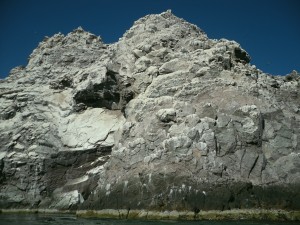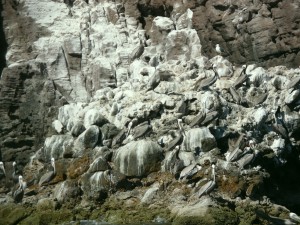On March 22, we took to the water to visit a tiny (1.7 km2) ancient volcanic island, Isla de San Pedro Martir. The island is a special place to visit, and is an oasis of biodiversity in the Gulf of California. The island is home to enormous nesting populations of birds, including the colorful blue- and brown-footed boobies (In Spanish, bobos de patas azules y cafes), and red-billed tropic birds (rabijuncos). Both species circle the island, the tropic birds made distinct by the long, white tails that flutter like a kite string behind them. The island also hosts sea lions (lobos marinos) that add their honking, and barking to the birds’ squawking, all of the sound echoing off the rocky walls of the island. I was lucky, in a way, that my camera battery had died just as we approached the island – I had nothing to distract me from taking everything in. As we came closer, the rocky crevices and shallow caves came into focus, followed by hundreds of white birds circling overhead. Then the sounds of the island, the birds and the sea lions; and then the smell of nitrogen from the centuries of guano coating the rocky walls. Cosme circled the island in less than 20 minutes, and we saw several rookeries where juvenile sea lions grouped together in shallow water – some followed us, maybe thinking we were a fishing vessel, and might toss the tailings of cleaned fish overboard.

The island is the centerpiece of a Marine Protected Area created in 2002 by the Mexican government’s National Commission for the Knowledge and Use of Biodiversity (CONABIO) after a great deal of work from several fishing and environmental advocacy groups, including CoBi. CoBi stands for “Comunidad y Biodiversidad” (Community and Biodiversity) and works to “promote marine biodiversity conservation through community participation.” CoBi in part helped influence the development of a new form of management that calls for representation and direct participation of the community. Some users include Kino Bay fishermen who dive to catch commercial fish, such as scallops, squid, and reef fish. CoBi trained a group of eight Kino Bay diving fishermen to observe biodiversity of juvenile reef fish and invertebrate populations, in order to monitor biodiversity at places like San Pedro Martir.

Early Thursday morning we boarded the Albatross in the yard of the Prescott Station and were driven to put into the water in Kino. The small vessel was a comfortable fit for the class, as well as our guides: Cosme our captain; Hector, a marine mammal specialist at the Prescott Station, and Polo, a former Kino fisherman who was trained by CoBi to participate in monitoring fisheries. Polo fished in the Gulf in areas around Kino for 34 years, and although he could earn a lot of money from fishing, he loves his new work with CoBi. He and other monitors return to San Pedro Martir Island each October and May to record observations on the invertebrate and juvenile fish populations present in the surrounding rocky reefs.


While talking with Polo and circling the island, I tried to consider what it was like for him to visit this place before and after he was trained to observe marine life. While I do not imagine that anyone could ignore the astounding beauty of the island, however after training with CoBi, Polo returned to San Pedro Martir with a different purpose from when he was a fisherman: to count the wildlife, not to catch it. He contributes his observations to research used to monitor island biodiversity and aid managing fishermen in the area. As a female American student, it would be a challenge for me to completely understand Polo’s perspective as a local Kino fisherman. I think it is at the least fair to say we both appreciate the island as fortunate visitors to witness the rich abundance of life centered there.
